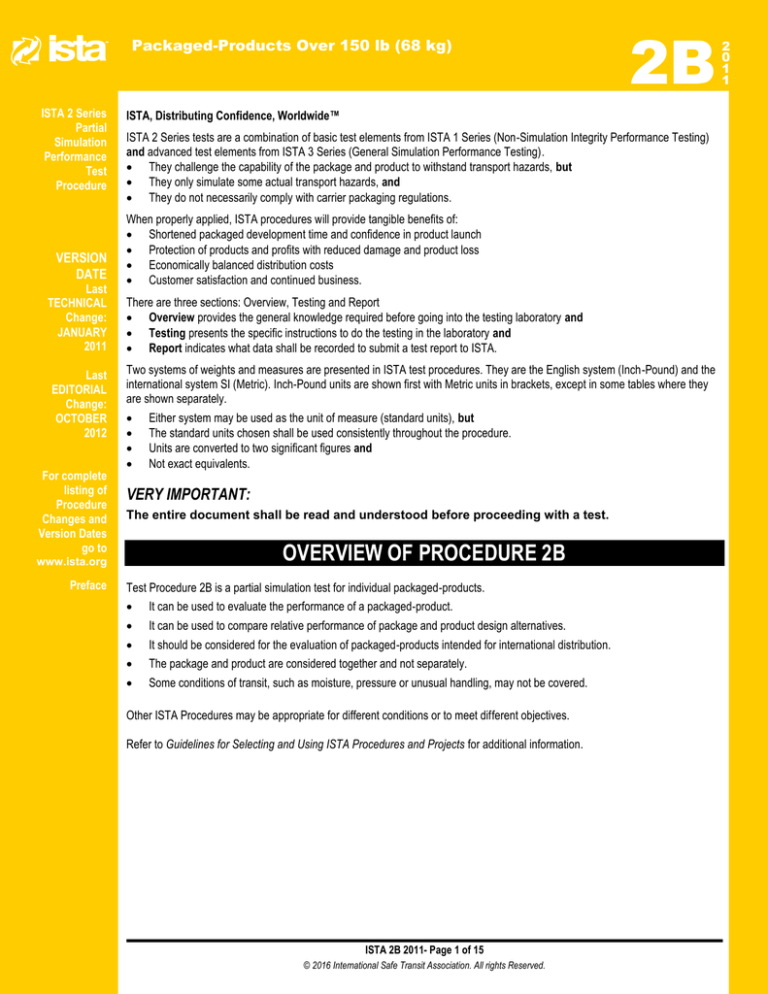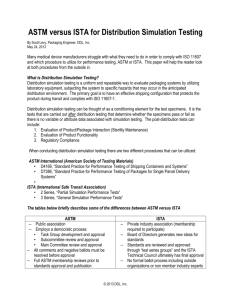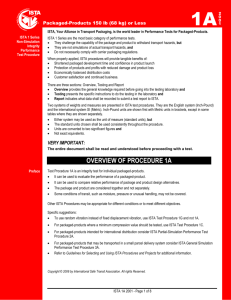
Packaged-Products Over 150 lb (68 kg)
ISTA 2 Series
Partial
Simulation
Performance
Test
Procedure
VERSION
DATE
Last
TECHNICAL
Change:
JANUARY
2011
Last
EDITORIAL
Change:
OCTOBER
2012
For complete
listing of
Procedure
Changes and
Version Dates
go to
ISTA, Distributing Confidence, Worldwide™
ISTA 2 Series tests are a combination of basic test elements from ISTA 1 Series (Non-Simulation Integrity Performance Testing)
and advanced test elements from ISTA 3 Series (General Simulation Performance Testing).
They challenge the capability of the package and product to withstand transport hazards, but
They only simulate some actual transport hazards, and
They do not necessarily comply with carrier packaging regulations.
When properly applied, ISTA procedures will provide tangible benefits of:
Shortened packaged development time and confidence in product launch
Protection of products and profits with reduced damage and product loss
Economically balanced distribution costs
Customer satisfaction and continued business.
There are three sections: Overview, Testing and Report
Overview provides the general knowledge required before going into the testing laboratory and
Testing presents the specific instructions to do the testing in the laboratory and
Report indicates what data shall be recorded to submit a test report to ISTA.
Two systems of weights and measures are presented in ISTA test procedures. They are the English system (Inch-Pound) and the
international system SI (Metric). Inch-Pound units are shown first with Metric units in brackets, except in some tables where they
are shown separately.
Either system may be used as the unit of measure (standard units), but
The standard units chosen shall be used consistently throughout the procedure.
Units are converted to two significant figures and
Not exact equivalents.
VERY IMPORTANT:
The entire document shall be read and understood before proceeding with a test.
OVERVIEW OF PROCEDURE 2B
www.ista.org
Preface
2B
Test Procedure 2B is a partial simulation test for individual packaged-products.
It can be used to evaluate the performance of a packaged-product.
It can be used to compare relative performance of package and product design alternatives.
It should be considered for the evaluation of packaged-products intended for international distribution.
The package and product are considered together and not separately.
Some conditions of transit, such as moisture, pressure or unusual handling, may not be covered.
Other ISTA Procedures may be appropriate for different conditions or to meet different objectives.
Refer to Guidelines for Selecting and Using ISTA Procedures and Projects for additional information.
ISTA 2B 2011- Page 1 of 15
© 2016 International Safe Transit Association. All rights Reserved.
2
0
1
1
2B
Scope
OVERVIEW OF PROCEDURE 2B
Test Procedure 2B covers testing of individual packaged-products weighing more than 150 lb (68 kg) when prepared for shipment.
EXCEPTION:
Individual packaged-products on a visible skid or pallet may be tested according to ISTA Non-Simulation Integrity Performance
Test Procedure 1E or ISTA General Simulation Performance Test Procedure 3E.
Product Damage
Tolerance and
Package
Degradation
Allowance
The shipper shall determine the following prior to testing:
what constitutes damage to the product and
what damage tolerance level is allowable, if any, and
the correct methodology to determine product condition at the conclusion of the test and
the acceptable package condition at the conclusion of the test.
NOTE:
When conducting the Compression Test:
box failure that could result in a stacking failure is considered a failed test, if
the packaged-product may be warehoused during distribution.
box failure is allowed if the packaged-product provided is not warehoused, and
at the conclusion of all testing, the product is not damaged according the Product Damage Tolerance established and
the package still meets the acceptable package condition, both of which are determined above.
For additional information on this determination process refer to Guidelines for Selecting and Using ISTA Procedures and Projects.
Samples
Samples should be the untested actual package and product, but if one or both are not available, the substitutes shall be as
identical as possible to actual items.
Number of samples required:
One sample is required for the tests in this procedure.
Replicate Testing Recommended:
To permit an adequate determination of representative performance of the packaged-product, ISTA:
Requires the procedure to be performed one time, but
Recommends performing the procedure five or more times using new samples with each test.
NOTE:
Packages that have already been subjected to the rigors of transportation cannot be assumed to represent standard conditions. In
order to insure testing in perfect condition, products and packages shipped to certified laboratories for testing must be:
over-packaged for shipment to the laboratory or
repackaged in new packaging at the laboratory.
ISTA 2B 2011- Page 2 of 15
© 2016 International Safe Transit Association. All rights Reserved.
2B
Test Sequence
OVERVIEW OF PROCEDURE 2B
The tests shall be performed on each test sample in the sequence indicated in the following table:
Sequence #
Test Category
Test Type
1
Atmospheric
Preconditioning
Temperature and Humidity
2
Atmospheric
Conditioning
Controlled Temperature and Temperature and Humidity
Humidity
chosen from chart
Required
Compression
Machine Apply and Release Calculated Test Force x
1.4
Required
3
(Alternative methods
allowed – select one
test type)
4
Vibration
(Alternative methods
allowed – select one
test type)
5
6
7
Test Level
Ambient
Machine Apply and Hold
Calculated Test Force
Weight and Load Spreader
Calculated Test Load
Fixed Displacement
1 in (25mm) peak to peak
at a frequency to be
determined
Random
Overall Gr m s level of 1.15
Shock
Drop
(Alternative methods
allowed – select one
test type)
Incline Impact (Conbur)
69 in (1.7 m) per second
velocity change
Horizontal Impact
69 in (1.7 m) per second
velocity change
Shock
Rotational Edge Drop
Vibration
Fixed Displacement
1 in (25mm) peak to peak
at a frequency to be
determined
Random
Overall Gr m s level of 1.15
(Alternative methods
allowed – select one
test type)
6 in (150 mm)
8 in (200 mm)
For ISTA Certification
Required
Required
Required
Required when not
testing face 1
Required
* Note: It is permissible to use either the same method of vibration or different methods of vibration in Sequences #4 and
#7. Both Sequences may use Fixed Displacement vibration, both may use Random vibration, or one may use Fixed
Displacement and the other Random. The Test Report should clearly document which type of vibration was used for each
Sequence number.
ISTA 2B 2011- Page 3 of 15
© 2016 International Safe Transit Association. All rights Reserved.
2B
EQUIPMENT REQUIRED FOR PROCEDURE 2B
Equipment
Required
Atmospheric
Conditioning
Atmospheric Conditioning:
Equipment
Required
Compression
The following alternatives are acceptable for the equipment required for the Compression Test:
Equipment
Required
Vibration
Chamber and Control apparatus complying with the apparatus section of ASTM D 4332.
Humidity recording apparatus complying with the apparatus section of ASTM D 4332.
Temperature recording apparatus complying with the apparatus section of ASTM D 4332.
Type of Compression Test
Equipment
In compliance with the apparatus section of:
Apply and Release Test
Compression test system
Apply and Hold Test
Compression test system
ASTM D 642
Fixed or Floating platen acceptable
Apply and Hold Test
Weight and load spreader
NA
The following alternatives are acceptable for the equipment required for the Vibration Test:
Fixed Displacement Vibration Test:
Vibration Test System with a 1 in (25 mm) fixed or controlled displacement complying with Method A1 or A2 of the apparatus
section of ASTM D 999.
Rotary or vertical linear motion of the platform is acceptable.
Metal shim 0.06 in (1.5 mm), thick approximately 2 in (50 mm) wide and at a convenient length.
Tachometer or suitable indicator for determining vibration frequency in cycles per second (Hz) or cycles per minute (CPM).
Automatic timer or stopwatch.
Random Vibration Test:
Random Vibration Test System complying with the apparatus section of ASTM D 4728.
Equipment
Required
Shock
The following alternatives are acceptable for the equipment required for the Shock Test:
Type of Shock Test
Equipment
In compliance with the apparatus section of:
Drop Test
Free fall drop tester
ASTM D 5276
Vertical Shock Test
Shock test machine
ASTM D 5487
Incline Test
Incline impact tester (conbur)
ASTM D 880
Horizontal Test
Horizontal impact test system
ASTM D 4003
Rotational Test
Rotational drop
ASTM D 6179
ISTA 2B 2011- Page 4 of 15
© 2016 International Safe Transit Association. All rights Reserved.








